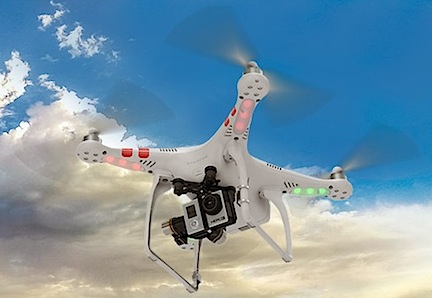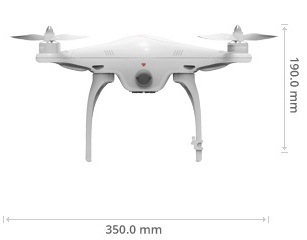Once again, no one is thinking about helicopters.
An aviation friend of mine, Rod, posted a note on Facebook titled “The Drone Industry Should Play by the Rules, or Help Change Them.” I’m not sure if you need to be logged into Facebook to read what he posted, so I’ll just echo it here; I do urge you to read and comment on it there if you can and have something to add to the discussion:
Look folks, I’ve got no problem with drones operating outside the National Airspace System. (i.e. below 400 feet.)
But if this innovative industry wants to conduct business in the NAS, you should have to play by the same rules as manned systems and certify the operators, the components, and the systems to the standards required by law.
If you don’t like the regulations that currently govern how the NAS is managed, help get the laws changed and deregulate aviation.
I asked where the 400-feet number comes from, pointing out that I’m authorized by the FAA to operate under Part 135 as low as 300 feet with passengers on board. He linked to an article on Politico about a lawsuit pending by the FAA against an “aerial anarchist” who uses a styrofoam plane for commercial aerial photography. From that article:
The FAA has never officially regulated model airplanes or small drones. The closest it has come was an “advisory” issued in 1981 that created a set of voluntary guidelines for model aircraft: stay within the line of sight, do not fly within three miles of an airport, do not fly a model airplane higher than 400 feet.
The article makes interesting reading, although it entirely misses the point of my problem with the kind of RC aircraft that are becoming more and more prevalent among amateur “drone pilots.” My problem has to do with the operation of these devices in areas where I fly, which can be within 400 feet of the ground, causing a nearly invisible hazard to me and my passengers.
As a helicopter pilot, I have no minimum flight altitude for my Part 91 operations — including aerial photography/videography, cherry drying, frost control, animal herding, wildlife survey — the list goes on and on. Part 91 allows me to fly as close to the ground as I need to (as long as I don’t create a hazard to people and property on the ground, of course). These are legitimate and legal low-level helicopter missions that often keep me within 100 feet of the ground. As previously mentioned, even my Part 135 operations allow me to operate as low as 300 feet above the ground.
 The Phantom 2 Quadcopter with a GoPro Hero attached. This aircraft can weigh nearly 3 pounds. How’d you like to get hit on the head with that dropping from 400 feet?
The Phantom 2 Quadcopter with a GoPro Hero attached. This aircraft can weigh nearly 3 pounds. How’d you like to get hit on the head with that dropping from 400 feet?
Imagine this scenario: I’m drying a cherry orchard and a local photo hobbyist decides to take out his Quadcopter with GoPro to get some footage of me or another cherry drying pilot in action. He keeps a respectable distance but is not prepared when one of us suddenly lifts up away from the trees and moves to another orchard. We don’t see him — we’re focused on our work and the location of other helicopter traffic — and one of us flies right into him. The helicopter’s cockpit bubble is smashed or the main rotor blades are damaged or, worse yet, the tail rotor is taken out and the aircraft crashes to the ground. Who’s right or wrong here? The drone is operating under 400 feet and at least 3 miles from the airport, so he’s “legal.” The helicopter pilots are performing a mission that we’ve been doing for years, relying on proven safety measures and radio communication to avoid obstacles and other traffic. Are we supposed to keep an eye out for amateur RC aircraft operators, too?
My aviation friend, Rod, suggests that drone operators should “help get the laws changed and deregulate aviation.” Does he really want aviation deregulated? Does he really want a free-for-all by anyone with a few hundred dollars to spend on an RC aircraft to fly it wherever they like for whatever purpose they desire?
Doesn’t he realize that it’s only a matter of time before they stray up into his previously safe airplane altitude?

The Phantom Quadcopter is small and white, less than 14 inches wide. I’ve seen birds bigger than that.
And what are helicopter pilots supposed to do? How do you think I feel worrying that any one of my flights could be ended by a collision with an RC aircraft piloted by a hobbyist with a new toy who doesn’t care about the rules or safety? Someone who mistakenly thinks it’s my responsibility, while cruising at 80 knots, to keep an eye out for his toy? Something that might not much larger than a Frisbee?
And make no mistake about it: an impact on a main rotor blade or tail rotor could disable my helicopter and cause a crash.
What would I like to see? Here are a few suggestions for the operation of unmanned radio or computer controlled aircraft:
- Limit amateur/hobbyist operations to designated RC aircraft fields that are marked on aeronautical charts.
- Require professional/commercial operators to receive training and pass tests established and overseen by the FAA.
- Require professional/commercial operators to publish NOTAMS whenever an operation outside an RC aircraft field is conducted.
- Require all operations to be conducted with a spotter to keep an eye out for full-sized aircraft operating in the area.
- Limit all operations to altitudes below 300 feet AGL.
I firmly believe that these aircraft, when operated by amateurs, are a danger not only to other aircraft but to people on the ground. There have been numerous crashes in populated areas, including one in Manhattan, and even a death attributed to a crash. How long will the FAA wait before it steps in and properly regulates these aircraft? These aircraft are proliferating at an alarming rate. As a pilot and property owner, I’m starting to get tired of worrying about the consequences of a careless operator’s actions.
And no: deregulating is not the answer we need.
—
February 26, 2014 Update: The FAA has spoken.
—




